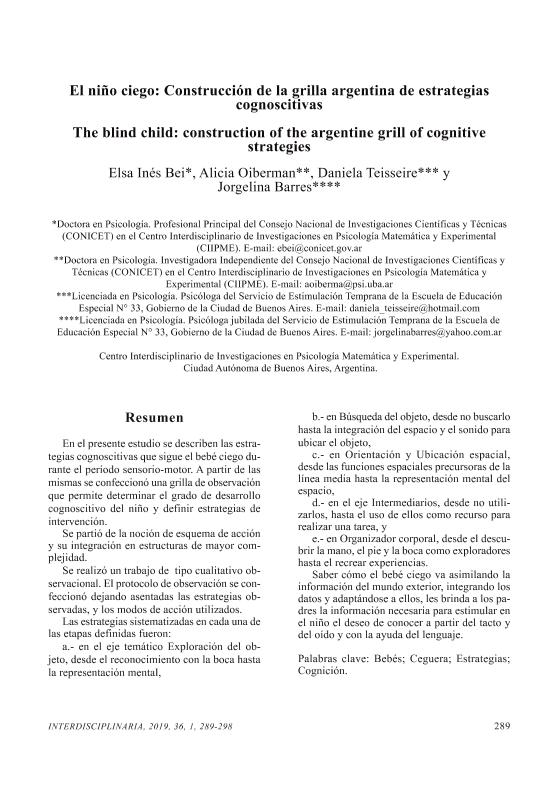Mostrar el registro sencillo del ítem
dc.contributor.author
Bei, Elsa Ines

dc.contributor.author
Oiberman, Alicia Juana

dc.contributor.author
Teisseire, Daniela
dc.contributor.author
Barres, Jorgelina
dc.date.available
2020-06-17T20:21:01Z
dc.date.issued
2019-07
dc.identifier.citation
Bei, Elsa Ines; Oiberman, Alicia Juana; Teisseire, Daniela; Barres, Jorgelina; El niño ciego: Construcción de la grilla argentina de estrategias cognoscitivas; Consejo Nacional de Investigaciones Científicas y Técnicas. Centro Interamericano de Investigaciones Psicológicas y Ciencias Afines; Consejo Nacional de Investigaciones Científicas y Técnicas. Centro Interdisciplinario de Investigaciones en Psicología Matemática y Experimental; Interdisciplinaria; 36; 1; 7-2019; 289-298
dc.identifier.issn
0325-8203
dc.identifier.uri
http://hdl.handle.net/11336/107583
dc.description.abstract
En el presente estudio se describen las estrategias cognoscitivas que sigue el bebé ciego durante el período sensorio-motor. A partir de las mismas se confeccionó una grilla de observación que permite determinar el grado de desarrollo cognoscitivo del niño y definir estrategias de intervención.Se partió de la noción de esquema de acción y su integración en estructuras de mayor complejidad. Se realizó un trabajo de tipo cualitativo observacional. El protocolo de observación se confeccionó dejando asentadas las estrategias observadas, y los modos de acción utilizados. Las estrategias sistematizadas en cada una de las etapas definidas fueron:a.- en el eje temático Exploración del objeto, desde el reconocimiento con la boca hasta la representación mental,b.- en Búsqueda del objeto, desde no buscarlo hasta la integración del espacio y el sonido para ubicar el objeto,c.- en Orientación y Ubicación espacial, desde las funciones espaciales precursoras de la línea media hasta la representación mental del espacio,d.- en el eje Intermediarios, desde no utilizarlos, hasta el uso de ellos como recurso para realizar una tarea, ye.- en Organizador corporal, desde el descubrir la mano, el pie y la boca como exploradores hasta el recrear experiencias.Saber cómo el bebé ciego va asimilando la información del mundo exterior, integrando los datos y adaptándose a ellos, les brinda a los padres la información necesaria para estimular en el niño el deseo de conocer a partir del tacto y del oído y con la ayuda del lenguaje.
dc.description.abstract
In the present study, the cognitive strategies that the blind baby follows during the sensory - motor period were established. From these observed strategies there was made a cricket of observation that allows to determine the degree of cognitive development of the blind child and to define possible guidelines of action. It started from the notion of "action plan" present in this stage and its integration in structures that will allow to achieve a new level of development and the concept of "affordance", which implies recognizing what the environment offers us, what responds to our interest. An observational qualitative work was carried out. The observation protocol was prepared leaving the observed strategies established, and the "modes of action" used by the child indicated the different strategies. In the developed game certain elements such as ribbons, rings, balls with rattle, support with rotating wooden disk, cars, piano, animals with sound and textures was offered to the child. The strategies systematized through the four stages defined are: a.- in the thematic axis Exploration of the object, from the recognition with the mouth to the mental representation, b.- in the Search of the object, from not looking for it until the integration of space and sound to locate the object, c.- in Orientation and Spatial Location, from the spatial functions precursors of the midline to the mental representation of space, d.- on the Intermediaries axis, from not using them, to using them as a resource to perform a task, and e.- in body Organizer, from discovering the hand, foot and mouth as explorers to recreating experiences. Body organizer was considered to be functioning structures that are guidelines for integration and access to a more complex structure. They are sequential moments in which a growing complexity is observed that goes from the undifferentiated to the organized and structured. Reference is made to an active exploratory sense. This active touch, precursor of the haptic sense in which receptors participate in the skin and in joints and tendons. This exploration allows him to perceive the world and in the case of the blind child, it makes it possible to experience new practices that can compensate for the lack of vision
dc.format
application/pdf
dc.language.iso
spa
dc.publisher
Consejo Nacional de Investigaciones Científicas y Técnicas. Centro Interamericano de Investigaciones Psicológicas y Ciencias Afines; Consejo Nacional de Investigaciones Científicas y Técnicas. Centro Interdisciplinario de Investigaciones en Psicología Matemática y Experimental
dc.rights
info:eu-repo/semantics/openAccess
dc.rights.uri
https://creativecommons.org/licenses/by-nc-sa/2.5/ar/
dc.subject
Bebé
dc.subject
Estrategias
dc.subject
Ceguera
dc.subject
Cognición
dc.subject.classification
Psicología especial

dc.subject.classification
Psicología

dc.subject.classification
CIENCIAS SOCIALES

dc.title
El niño ciego: Construcción de la grilla argentina de estrategias cognoscitivas
dc.title
The blind child: Construction of the argentine grill of cognitive strategies
dc.type
info:eu-repo/semantics/article
dc.type
info:ar-repo/semantics/artículo
dc.type
info:eu-repo/semantics/publishedVersion
dc.date.updated
2020-04-24T17:57:23Z
dc.identifier.eissn
1668-7027
dc.journal.volume
36
dc.journal.number
1
dc.journal.pagination
289-298
dc.journal.pais
Argentina

dc.journal.ciudad
Ciudad Autónoma de Buenos Aires
dc.description.fil
Fil: Bei, Elsa Ines. Consejo Nacional de Investigaciones Científicas y Técnicas. Oficina de Coordinación Administrativa Saavedra 15. Centro Interdisciplinario de Investigaciones en Psicología Matemática y Experimental Dr. Horacio J. A. Rimoldi; Argentina
dc.description.fil
Fil: Oiberman, Alicia Juana. Consejo Nacional de Investigaciones Científicas y Técnicas. Oficina de Coordinación Administrativa Saavedra 15. Centro Interdisciplinario de Investigaciones en Psicología Matemática y Experimental Dr. Horacio J. A. Rimoldi; Argentina
dc.description.fil
Fil: Teisseire, Daniela. Escuela de Educación Especial Numero 33; Argentina
dc.description.fil
Fil: Barres, Jorgelina. Escuela de Educación Especial Numero 33; Argentina
dc.journal.title
Interdisciplinaria
dc.relation.alternativeid
info:eu-repo/semantics/altIdentifier/doi/http://dx.doi.org/10.16888/interd.2019.36.1.19
dc.relation.alternativeid
info:eu-repo/semantics/altIdentifier/url/https://www.redalyc.org/articulo.oa?id=18060087019
dc.relation.alternativeid
info:eu-repo/semantics/altIdentifier/url/http://www.ciipme-conicet.gov.ar/ojs/index.php?journal=interdisciplinaria&page=article&op=view&path%5B%5D=https%3A%2F%2Fdoi.org%2F10.16888%2Finterd.36.1.19
dc.relation.alternativeid
info:eu-repo/semantics/altIdentifier/url/http://www.scielo.org.ar/pdf/interd/v36n1/v36n1a19.pdf
Archivos asociados
